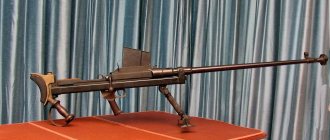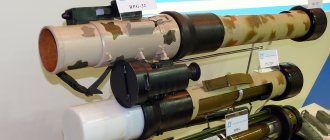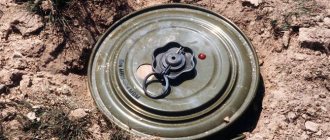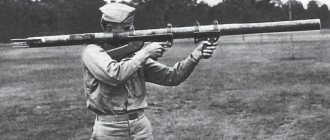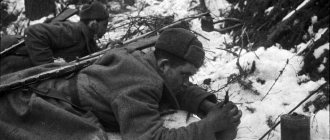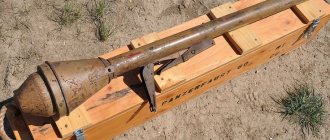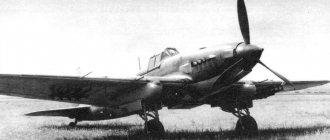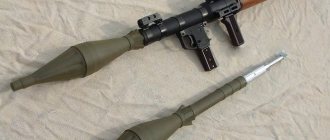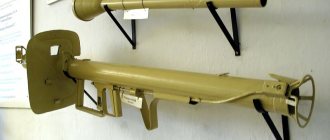Grenade launchers | Germany
Grenade launcher GzB-39
Since 1942, obsolete PzB-39 anti-tank rifles were converted into GrB-39 grenade launchers by reducing the length of the barrel and placing a mortar on its muzzle for firing a cumulative armor-piercing grenade. The sighting device consisted of a front reticle sight and a rear rear sight sight. The grenade launcher was equipped with a bipod that folded in the stowed position and a metal butt that rotated down and forward. To carry the grenade launcher, there was a handle located on top of the front part of the receiver. A special blank cartridge (Treibpatrone 318) was used as a charge for throwing grenades, which made it possible to use several types of grenades. In total, 28 thousand units were converted. Performance characteristics of the grenade launcher: mortar caliber – 30 mm; mortar weight – 0.8 kg; grenade launcher weight - 10.5 kg; barrel length - 590 mm; mortar length – 130 mm; grenade launcher length – 1230 mm; sighting range - 150 m; initial grenade speed - 65 m/s; armor penetration - 80 mm at a distance of 150 m; rate of fire - 5-8 rounds per minute.
30 mm rifle grenade launcher Gewehrgranatgerät / Schiessbecher
Mauser K-98k carbine with rifle grenade launcher
In 1940, the Wehrmacht adopted the 30-mm rifle grenade launcher “Gewehrgranatgerät” (mortar for rifle grenades), also called “Schiessbecher”. It was used to combat armored vehicles and tanks. The grenade launcher fired fragmentation and armor-piercing (cumulative) rifle grenades, and a propaganda grenade was often used. Structurally, the grenade launcher was a conventional mortar attached to the muzzle of the 98k carbine and capable of firing grenades. To turn a rifle into a grenade launcher, a soldier had only to attach a mortar to the cut of the barrel. The grenade launcher's sighting device was mounted using a clamp to the left of the standard rifle sight. The mortar, scope and grenades in cases are carried in special bags. The grenade launcher could also be installed on the Gewehr-43, StG-44 assault rifles and the FG-42 airborne rifle. The grenade launcher was produced until May 1944. A total of 1.5 million units were produced. Performance characteristics of the grenade launcher: mortar caliber - 30 mm; mortar length - 250 mm; mortar weight – 0.8 kg; sight weight – 0.4 kg; target firing range - 250 m; armor penetration - 40 - 80 mm depending on the grenade used.
Leuchtpistole grenade launcher with shoulder rest
Leuchtpistole with grenade
To create powerful close-combat infantry weapons, Germany developed a number of grenade launcher systems based on 26-mm signal pistols (rocket launchers). The first grenade launcher was created in 1942 from the Leuchtpistole signal pistol mod. 1928 or mod. 1934 and grenade: anti-personnel fragmentation 326-LP; anti-tank cumulative - 326-HL/LP and N-26LP; anti-personnel fragmentation 361-LP two samples. To conduct targeted shooting from this grenade launcher, a metal shoulder rest with folding nape pads was developed, which was attached to the pistol frame with a clamping device. A folding sight was mounted on the barrel. Loading the grenade did not require additional accessories and was carried out from the breech, similar to loading with signal and lighting cartridges. Pistol fragmentation grenades were used, as a rule, for mounted firing at a distance of up to 70 - 80 m to combat enemy personnel in the offensive and defensive, suppress firing points in populated areas, and also to make passages in wire barriers. Performance characteristics of the grenade launcher: length with stock - 590 mm, without stock - 254 mm; barrel length – 98 mm; sample mass 1928 (with a steel barrel and frame) - 2.5 kg, and the weight of the 1934 model, made of aluminum - 1.9 kg; sighting range – 200 m;
Kampfpistole with folded shoulder rest
Kampfpistole with grenade without shoulder rest
In 1942, based on the Leuchtpistole signal pistol, a special 26-mm Kampfpistole (Z) combat pistol was developed. Unlike its smooth-bore predecessor, the Kampfpistole had five rifling in the barrel and significantly better combat characteristics - accuracy, efficiency and firing range. In addition, light metals were used in the design. A new graduated sight and spirit level were attached to the left side of the pistol body for aimed shooting. The weapon fired only caliber and over-caliber grenades, which were inserted from the muzzle of the barrel. The grenade launcher was equipped with a shoulder rest. A total of 25 thousand units were produced. Performance characteristics of the grenade launcher: weight – 780 g; sighting range – 200 m; armor penetration - 80 mm at a distance of 75 m.
Sturmpistole grenade launcher with insert barrel and sighting devices
To use the signal pistol, both for its intended purpose and for shooting grenades, an Einstecklauf insert-rifled barrel-liner was made for the Leuchtpistole rocket launcher. The new weapon is called the Sturmpistole assault pistol. For greater stability during shooting and increased combat accuracy, a folding shoulder rest was attached to its handle, and an attachment with a sight, designed for up to 200 m, was attached to the barrel. In total, 400 thousand barrel inserts were produced. Grenade launcher performance characteristics: caliber 26 mm; weight – 2.4 kg; length with the butt unfolded - 585 mm; barrel length – 180 mm.
Main modifications of the Panzerfaust grenade launcher
Serial production of a disposable hand-held anti-tank grenade launcher called “Faustpatrone” or “Panzerfaust” began in the summer of 1943. Almost all Faustpatron models had the same design - they consisted of a barrel and an over-caliber grenade. The barrel was a smooth-walled, seamlessly drawn pipe on the outer surface of which the impact mechanism was attached by welding. Inside the barrel there was a propellant charge. "Faustpatron" was a lightweight dynamo-reactive (without recoil when fired) weapon. It was focused on combat use not by specially trained crews, but by ordinary infantrymen. For a fighter to master the weapon, a five-minute instruction was enough. When a grenade was launched, a jet stream of up to 10 m was formed behind the shooter. In total, during the war years, the German industry produced 8.2 million grenade launchers of all modifications.
| Panzerfaust type | 30m (small) | 30m | 60m | 100m | 150m |
| Total weight, kg. | 2,7-3,2 | 6,9 | 8,5 | 9,4 | 6,5 |
| Length, mm. | 985 | 1045 | — | — | — |
| Grenade caliber, mm. | 100 | 149 | 149 | 149 | 106 |
| Effective firing range, m | 30 | 30 | 60 | 100 | 150 |
| Grenade flight speed, m/sec. | 28 | 45 | 45 | 60 | 85 |
| Armor penetration, mm. | 140 | 200 | 200 | 200 | 280-320 |
RPzB-43 “Ofenrohr” hand-held anti-tank grenade launcher
In 1943, based on the American 60-mm M-1 Bazooka anti-tank missile systems, an 88-mm German multi-charge analogue appeared, called RPzB-43 (Raketenpanzerbüchse-43) “Ofenrohr”. The system fired cumulative rockets. It consisted of a smooth-walled pipe open at both ends with three guides, a pulse generator with electrical wiring and a plug box, as well as a trigger mechanism and a sight. The weapon was serviced by a crew of two people - a gunner and a loader. To protect the shooter from fuel exhaust, a fireproof cape and a gas mask without a filter were used.
Shooter in combat gear with an RPzB-43 grenade launcher
Aiming was carried out through a sighting device consisting of two metal hooks. The pipe at the rear end had a ring that protected the channel from contamination and damage, and also made it easier to insert a grenade into the pipe channel. The tube also had a shoulder rest with a shoulder pad, two handles for holding the gun when aiming, two swivels with a belt for carrying a grenade launcher, and a spring latch for holding the mine in a loaded grenade launcher. To use a grenade launcher at night, a flare was fired behind the tank so that its silhouette was clearly visible to the shooter. RPzB-43 was produced in limited quantities. Performance characteristics of the grenade launcher: caliber – 88 mm; pipe length – 1640 mm; pipe weight – 9.3 kg; weight with grenade - 13 kg; firing range – 150 m; armor penetration - 150 mm; rate of fire - 10 rounds per minute; initial speed – 105 m/s.
Anti-tank grenade launcher RPzB-54
In 1944, a modification RPzB-43 appeared, equipped with a protective shield measuring 360x470 mm with a small mica window. This modification was called RPzB-54 (Panzerschreck). Anti-tank companies of motorized rifle regiments of tank divisions were armed primarily with grenade launchers at the rate of 36 rifles per company. A total of 289.1 thousand units were produced. Performance characteristics of the grenade launcher: caliber – 88 mm; length – 1640 mm; weight – 9.5 kg; grenade weight - 2.2 kg; sighting range – 150 m; rate of fire - 10 rounds per minute; initial speed - 115 m/s; armor penetration from a distance of 100 m – 210 mm.
Anti-tank grenade launcher RPzB-54/1
In 1945, the RPzB-54/1 model began to be produced. Unlike its predecessor, it had a shorter guide tube, lighter weight, a new ignition system and a sight. The guide tube could withstand up to 200 shots. A total of 25.7 thousand units were produced. Performance characteristics of the grenade launcher: tube length – 1350 mm; weight – 9.5 kg; calculation 2 people. An anti-aircraft modification of the grenade launcher is known under the designation “Fliegerschreck”, the grenade for which was equipped with a special warhead. However, until the end of the war, only 500 anti-aircraft anti-aircraft systems were produced.
Puppchen mounted grenade launcher on wheels
Puppchen mounted grenade launcher on skis
Puppchen mounted grenade launcher in firing position
In 1944, the 88-mm mounted anti-tank grenade launcher “Puppchen” was adopted by the German infantry.
The grenade launcher carriage consisted of an upper machine on which the barrel was mounted and a shield cover was secured, and a lower machine equipped with a single-beam frame and a wheel drive with two stamped wheels with rubber tires. To further camouflage the weapon on the ground, it was possible to change its height by removing the wheel travel. In this case, the grenade launcher was lowered onto special support blocks mounted on a carriage, to which ski-type stops were attached. The grenade launcher was aimed at the target manually; there were no turning or lifting mechanisms. There was also a shield cover made of armored steel 3 mm thick with edges curved inward and with a window for aiming. A total of 3,150 grenade launchers were fired. TTT grenade launcher: caliber – 88 mm; length – 1750 mm; width – 1025 mm; height – 895 mm; barrel length – 1600 mm; weight – 149 kg; grenade weight - 2.7 kg; initial grenade speed - 140 m/s; rate of fire - 10 rounds per minute; sighting range – 250 m, maximum range – 700 m; armor penetration from a distance of 100 m – 200 mm; calculation – 4 people. Share to:
Panzerschreck "thunderstorm of tanks"
At the beginning of 1943, in Tunisia, German troops captured the American Bazooka anti-tank grenade launcher (RPG). Its study, as well as the experience of HASAG (Hugo Schneider AG, Leipzig) in the development of the Schulder 75 rocket launcher, accelerated the creation of its own reusable RPG.
"Panzerschrek" was used on the Eastern and Western Fronts
Hitler was delighted by reports of the capabilities of Panzerfausts and Panzerschrecks. He demanded to increase production and equip advanced units with more of this type of weapon. The enormous scale of production is evidenced by the fact that during the battles for Poznan in 1945, Soviet troops intercepted a train carrying more than 25,000 Panzerfausts!
The total production of these weapons by the end of the war was 6.7 million units.
German grenade launcher in combat conditions
The Allies managed to capture thousands of Panzerfausts and Panzerschrecks. They were subjected to thorough technical tests, and the most interesting technical solutions were copied and used in the development of various types of weapons.

